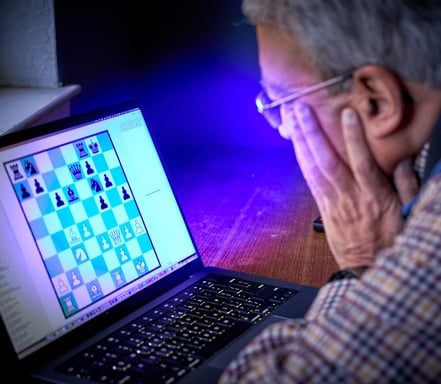Add your promotional text...
03. How Competitive Chess has Morphed
A huge part of competitive chess today is computer-aided home preparation.
Roy Prasad
1/10/20243 min read
In the past the best players played one another in matches and tournaments for bragging rights and small prize funds put up by some benefactor fan.
By early 20th century chess tournaments started becoming more frequent, backed by corporate or governmental sponsorships that provided meaningful prize funds. This paved the way for chess to become a way to supplement income, and eventually, led to chess as a profession for many of the top players.
Along with this, home preparation in openings became a growing part of playing chess competitively, for both professionals and amateurs. During the Cold War years, the Soviet School of Chess institutionalized the study of openings, in large part to neutralize strong Western players such as Samuel Reshevsky, Bobby Fischer and Bent Larsen.
Reshevsky, who had a career and was not a full-time chess professional, simply could not afford to study chess openings and compete with the Soviet players who were paid a salary by their government to study and play chess full time. As a result, Reshevsky routinely got into time trouble and lost many key games and repeatedly missed the opportunity to become the world champion. Mikhail Botvinnik’s win in his return match against Mikhail Tal was in large part based on superior openings preparation.
Over the past twenty years, advances in computer chess and software apps like Chessbase and Stockfish have dramatically scaled up home preparation. Today, primary variations in many popular opening systems like the Ruy Lopez, Sicilian Defense and Kings Indian Defense have been analyzed 25-30 moves, to almost the end game.
A player can pick an opening variation known to be favored by a specific opponent, then from a position reached after 15 or 20 moves, have software play thousands of simulated games to find the strongest continuations. With both players doing the same thing, we often see tournament games in which the players blitz their first 15-20 moves in seconds, until one player plays a brand new move the other player has not seen before, and a the real game starts only then, often with a lot of pieces and pawns having already been exchanged.
Today it is virtually impossible for professionals and even strong amateurs who want to play in chess tournaments to avoid spending inordinate amounts of time on openings preparation. Although chess is still very much a game of mind vs. mind and all opportunities remain for creative play over the board, it is hard to play well and discover the best moves with the clock ticking against an opponent who has already seen the future.
The daunting commitment to openings preparation also deters a lot of amateur players who would like to play competitively, if only they could simply walk into a tournament and play a game based on their skills, without having to worry about being ambushed by the opponent in the opening.
A weaker player who achieves a superior position by means of home preparation in the opening is unlikely to defeat a much stronger player, as Frank Marshall demonstrated with his surprise move against Jose Raul Capablanca in 1918. Marshall’s preparation was indeed brilliant and led to the famous Marshall Gambit in Ruy Lopez that is still being played today. But Marshall could not overcome the genius of Capablanca who won the game anyway.
Magnus Carlsen is known to play many inferior opening variations, even opening games with moves like 1. a3 or 1. h4, to take his opponent out of prepared variations. But a great player like Carlsen can do that and get away with it in rapid or blitz games, simply because he is so good. But even Carlsen has painfully discovered that playing inferior opening lines even against slightly weaker players has not turned out well when the game is played with classical time controls (e.g., 40 moves in 2 hours).
Between approximately equal players, home preparation in the openings is almost never enough to win a game outright or get an insurmountable positional advantage. However, it typically gains valuable time on the clock, forcing the opponent to think a lot and be left with less time when the game reaches a more critical stage. That is often enough to decide the game in favor of the better prepared player.
This is the problem G3 Chess is trying to address: to make home preparation in the openings largely irrelevant, and let players simply walk into a tournament and play games based on strategy, tactics and technique, not having to worry about memorization of opening lines or surprise opening variations to contend with.

